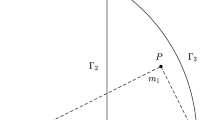Abstract
The elliptical orbits resulting from Newtonian gravitation are generated with a multifaceted symmetry, mainly resulting from their conservation of both angular momentum and a vector fixing their orientation in space—the Laplace or Runge-Lenz vector. From the ancient formalisms of celestial mechanics, I show a rather counterintuitive behavior of the classical hydrogen atom, whose orbits respond in a direction perpendicular to a weak externally-applied electric field. I then show how the same results can be obtained more easily and directly from the intrinsic symmetry of the Kepler problem. If the atom is subjected to an oscillating electric field, it enjoys symmetry in the time domain as well, which is manifest by quasi-energy states defined only modulo ħω. Using the Runge-Lenz vector in place of the radius vector leads to an exactly-solvable model Hamiltonian for an atom in an oscillating electric field—embodying one of the few meaningful exact solutions in quantum mechanics, and a member of an even more exclusive set of exact solutions having a time-dependent Hamiltonian. I further show that, as long as the atom suffers no change in principal quantum number, incident radiation will produce harmonic radiation with polarization perpendicular to the incident radiation. This unusual polarization results from the perpendicular response of the wavefunction, and is distinguished from most usual harmonic radiation resulting from a scalar nonlinear susceptibility. Finally, I speculate on how this radiation might be observed.
Similar content being viewed by others
References
H. Goldstein,Am. J. Phys. 43, 737–738 (1975);44, 1123 (1976).
F. J. Dyson, “Mathematics in the Physical Sciences”, inThe Mathematical Sciences: A Collection of Essays, edited by the National Research Council's Committee on support of Research in the Mathematical Sciences (The M.I.T. Press, Cambridge, Massachusetts and London, England, 1969), p. 97.
G. Houlton, “Einstein. The Life and Times,” by R. W. Clark, book review,New York Times Book Review, September 5, 1–20 (1971).
D. Aebersold and L. C. Biedenharn,Phys. Rev. A 15, 441 (1977).
V. A. Kostelecký and N. Russel,J. Math. Phys. 37, 2166 (1996).
G. C. Baldwin and J. C. Solem,Laser Phys. 5, 231 (1995).
G. C. Baldwin, J. C. Solem, and V. I. Gol'danskii,Rev. Mod. Phys. 53, 687 (1981).
K. Boyer and C. Rhodes,Phys. Rev. Lett. 54, 1490 (1985); C. Rhodes,Science 30, 1345 (1985).
L. C. Biedenharn, G. C. Baldwin, K. Boyer, and J. C. Solem, “Nuclear excitation by laserdriven coherent outer shell electron oscillation,” inAdvances in Laser Science W. C. Stwalley and M. Lapp, eds., Optical Engineering, Series 6 (American Institute of Physics, New York, 1986), p. 52.
J. C. Solem and L. C. Biedenharn,J. Quant. Spectrosc. Radial. Transfer 40, 707 (1988).
J. C. Solem,J. Quant. Spectrosc. Radial. Transfer 40, 713 (1988).
A. de Kertanguy, I. C. Percival, and D. Richards,J. Phys. B 14, 641 (1981).
A. E. Roy,Orbital Motion (Wiley, New York, 1978), p. 184; F. R. Moulton,An Introduction to Celestial Mechanics (Dover, New York, 1970), p. 404.
J. C. Solem,Am. J. Phys. 55, 906 (1987).
M. Born,Mechanics of the Atom (Bell, London, 1960).
L. C. Biedenharn and J. C. Louck,Angular Momentum in Quantum Physics, (Addison-Welsey, Reading, Massachusetts, 1981), p. 360.
L. C. Biedenharn, L. S. Brown, and J. C. Solem,Am. J. Phys. 56, 661 (1988).
J. C. Solem,Am. J. Phys. 57, 278 (1989).
See, for example, N. B. Delone and V. P. Krainov,Fundamentals of Nonlinear Optics of Atomic Gases, (Wiley, New York, 1988).
J. H. Shirley,Phys. Rev. B. 138, 979 (1965), Ya. B. Zel'dovichSov. Phys. JETP 24, 1006 (1967).
L. C. Biedenharn, G. A. Rinker, and J. C. Solem,J. Opt. Soc. Am. B. 6, 221 (1989).
W. Pauli,Z. Phys. 36, 336 (1926).
L. C. Biedenharn and J. D. Louck,Angular Momentum in Quantum Physics, G.-C. Rota, ed., Vol. 8 of theEncyclopedia of Mathematics and Applications, (Addison-Wesley, Reading, Massachusetts, 1981); see Chap. 7, Secs. 4 and 6.
I. Sobelman,Atomic Spectra and Radiative Transitions, (Springer, Berlin, 1979), p. 253.
Author information
Authors and Affiliations
Rights and permissions
About this article
Cite this article
Solem, J.C. Variations on the Kepler problem. Found Phys 27, 1291–1306 (1997). https://doi.org/10.1007/BF02551529
Received:
Issue Date:
DOI: https://doi.org/10.1007/BF02551529




